2007 CHEVROLET EQUINOX seats
[x] Cancel search: seatsPage 89 of 492
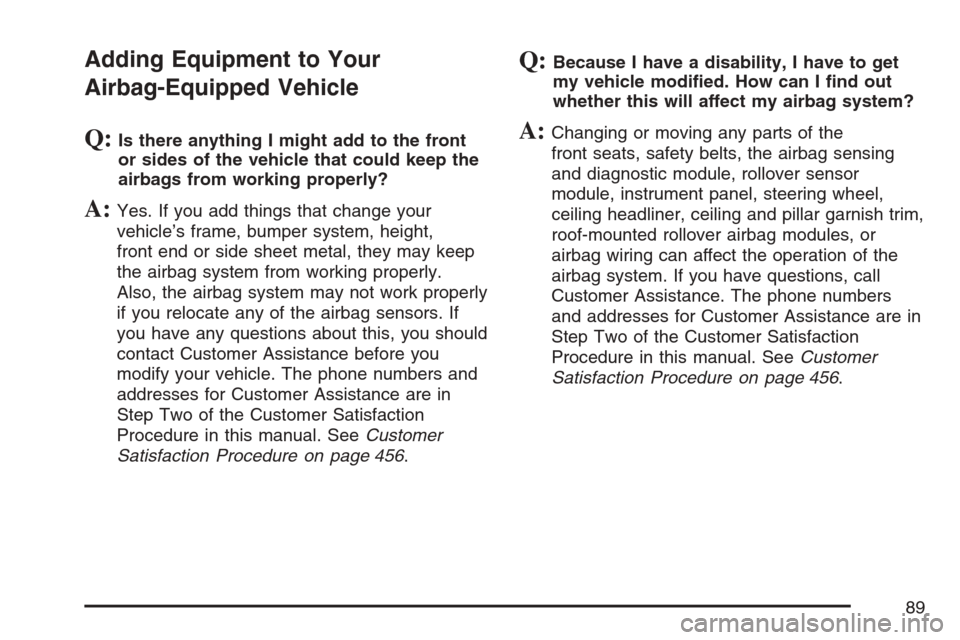
Adding Equipment to Your
Airbag-Equipped Vehicle
Q:Is there anything I might add to the front
or sides of the vehicle that could keep the
airbags from working properly?
A:Yes. If you add things that change your
vehicle’s frame, bumper system, height,
front end or side sheet metal, they may keep
the airbag system from working properly.
Also, the airbag system may not work properly
if you relocate any of the airbag sensors. If
you have any questions about this, you should
contact Customer Assistance before you
modify your vehicle. The phone numbers and
addresses for Customer Assistance are in
Step Two of the Customer Satisfaction
Procedure in this manual. SeeCustomer
Satisfaction Procedure on page 456.
Q:Because I have a disability, I have to get
my vehicle modi�ed. How can I �nd out
whether this will affect my airbag system?
A:Changing or moving any parts of the
front seats, safety belts, the airbag sensing
and diagnostic module, rollover sensor
module, instrument panel, steering wheel,
ceiling headliner, ceiling and pillar garnish trim,
roof-mounted rollover airbag modules, or
airbag wiring can affect the operation of the
airbag system. If you have questions, call
Customer Assistance. The phone numbers
and addresses for Customer Assistance are in
Step Two of the Customer Satisfaction
Procedure in this manual. SeeCustomer
Satisfaction Procedure on page 456.
89
Page 149 of 492

The main components of your instrument panel are the following:
A. Air Outlets. SeeOutlet Adjustment
on page 169.
B. Turn Signal/Multifunction Lever. SeeTurn
Signal/Multifunction Lever on page 151.
C. Instrument Panel Cluster. SeeInstrument
Panel Cluster on page 172.
D. Windshield Wiper/Washer Lever. See
Windshield Wipers on page 153.
E. Driver Information Center Controls. See
DIC Operation and Displays on page 193.
F. Hazard Warning Flashers. SeeHazard
Warning Flashers on page 150.
G. Passenger Airbag Status Indicator. See
Passenger Airbag Status Indicator on page 175.
H. Rear Window Wiper/Washer Buttons. See
Rear Window Wiper/Washer on page 155. Fog
Lamps Button. SeeFog Lamps on page 160.
I. Power Mirror Control. SeeOutside Power
Mirrors on page 132.
J. Instrument Panel Brightness Control. See
Instrument Panel Brightness on page 161.K. Cruise Controls. SeeCruise Control
on page 155.
L. Tilt Wheel. SeeTilt Wheel on page 151.
M. Horn. SeeHorn on page 150.
N. Audio Steering Wheel Controls. SeeAudio
Steering Wheel Controls on page 280.
O. Audio System. SeeAudio System(s)
on page 215.
P. Shift Lever. SeeShifting Into Park (P)
on page 123.
Q. Traction Control System (TCS) Button. See
Traction Control System (TCS) on page 291.
R. Power Window Switches. SeePower
Windows on page 110.
S. Climate Control System. SeeClimate
Control System on page 165. Heated Seat
Buttons (If Equipped). SeeHeated Seats
on page 10.
T. Glove Box. SeeGlove Box on page 137.
149
Page 163 of 492
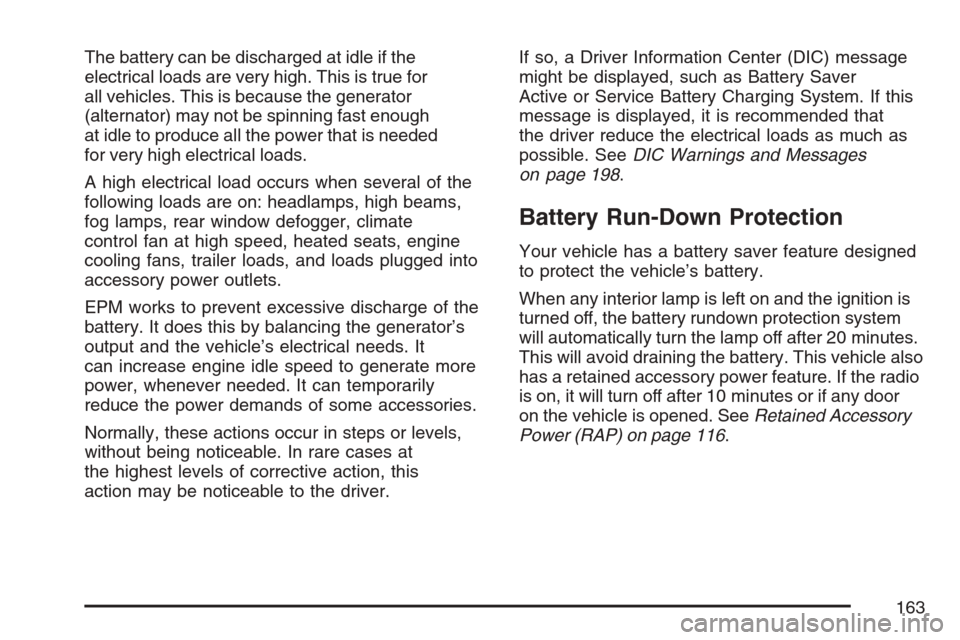
The battery can be discharged at idle if the
electrical loads are very high. This is true for
all vehicles. This is because the generator
(alternator) may not be spinning fast enough
at idle to produce all the power that is needed
for very high electrical loads.
A high electrical load occurs when several of the
following loads are on: headlamps, high beams,
fog lamps, rear window defogger, climate
control fan at high speed, heated seats, engine
cooling fans, trailer loads, and loads plugged into
accessory power outlets.
EPM works to prevent excessive discharge of the
battery. It does this by balancing the generator’s
output and the vehicle’s electrical needs. It
can increase engine idle speed to generate more
power, whenever needed. It can temporarily
reduce the power demands of some accessories.
Normally, these actions occur in steps or levels,
without being noticeable. In rare cases at
the highest levels of corrective action, this
action may be noticeable to the driver.If so, a Driver Information Center (DIC) message
might be displayed, such as Battery Saver
Active or Service Battery Charging System. If this
message is displayed, it is recommended that
the driver reduce the electrical loads as much as
possible. SeeDIC Warnings and Messages
on page 198.
Battery Run-Down Protection
Your vehicle has a battery saver feature designed
to protect the vehicle’s battery.
When any interior lamp is left on and the ignition is
turned off, the battery rundown protection system
will automatically turn the lamp off after 20 minutes.
This will avoid draining the battery. This vehicle also
has a retained accessory power feature. If the radio
is on, it will turn off after 10 minutes or if any door
on the vehicle is opened. SeeRetained Accessory
Power (RAP) on page 116.
163
Page 167 of 492
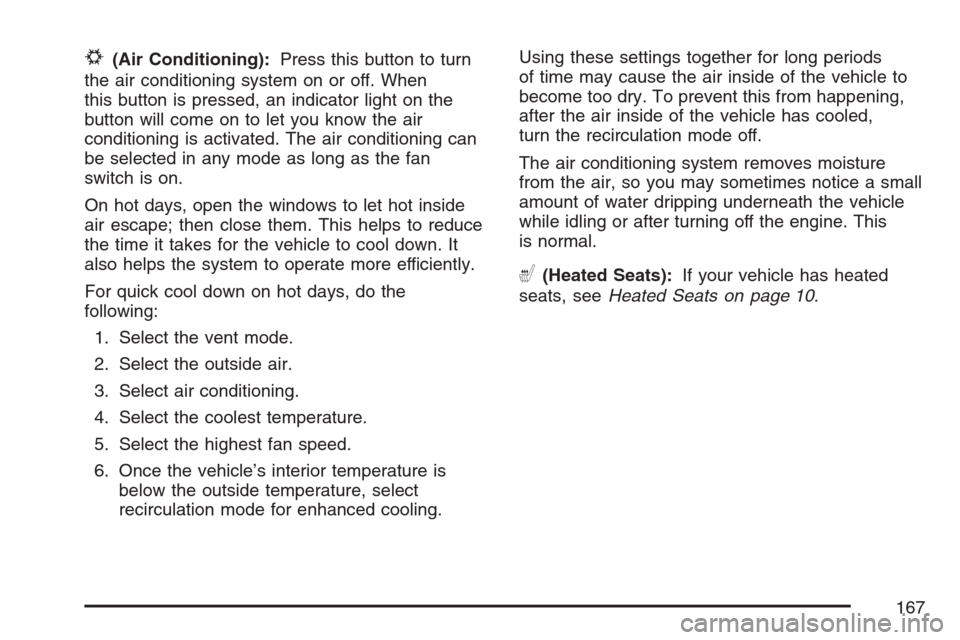
#(Air Conditioning):Press this button to turn
the air conditioning system on or off. When
this button is pressed, an indicator light on the
button will come on to let you know the air
conditioning is activated. The air conditioning can
be selected in any mode as long as the fan
switch is on.
On hot days, open the windows to let hot inside
air escape; then close them. This helps to reduce
the time it takes for the vehicle to cool down. It
also helps the system to operate more efficiently.
For quick cool down on hot days, do the
following:
1. Select the vent mode.
2. Select the outside air.
3. Select air conditioning.
4. Select the coolest temperature.
5. Select the highest fan speed.
6. Once the vehicle’s interior temperature is
below the outside temperature, select
recirculation mode for enhanced cooling.Using these settings together for long periods
of time may cause the air inside of the vehicle to
become too dry. To prevent this from happening,
after the air inside of the vehicle has cooled,
turn the recirculation mode off.
The air conditioning system removes moisture
from the air, so you may sometimes notice a small
amount of water dripping underneath the vehicle
while idling or after turning off the engine. This
is normal.
((Heated Seats):If your vehicle has heated
seats, seeHeated Seats on page 10.
167
Page 169 of 492

ACC or LOCK. If turned on again, the defogger
will only run for about �ve minutes before turning
off. The defogger can also be turned off by pressing
the button again or by turning off the engine.
Notice:Do not use anything sharp on the
inside of the rear window. If you do, you could
cut or damage the warming grid, and the repairs
would not be covered by your warranty. Do not
attach a temporary vehicle license, tape, a decal
or anything similar to the defogger grid.
Outlet Adjustment
Use the louvers located on the air outlets to
change the direction of the air�ow.
Operation Tips
Clear away any ice, snow, or leaves from the
air inlets at the base of the vehicle that may
block the �ow of air into your vehicle.
Do not use any non-GM approved hood
de�ectors that could adversely affect the
performance of the system.
Keep the path under the front seats clear
of objects to help circulate the air inside
of your vehicle more effectively.
Passenger Compartment Air Filter
The outside air is routed through a passenger
compartment air �lter before entering the vehicle.
This �lter removes certain particles from the
air, including pollen and dust particles. Reductions
in air�ow, which may occur more quickly in
dusty areas, indicate that the �lter needs to be
replaced early.
The �lter should be replaced as part of routine
scheduled maintenance. SeeScheduled
Maintenance on page 439for when to replace
the �lter.
169
Page 198 of 492
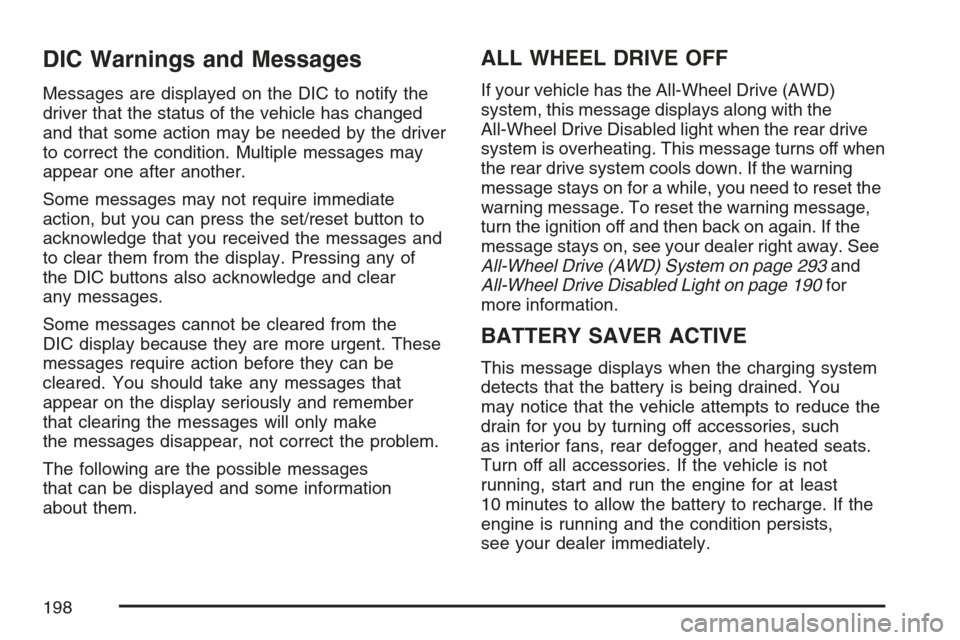
DIC Warnings and Messages
Messages are displayed on the DIC to notify the
driver that the status of the vehicle has changed
and that some action may be needed by the driver
to correct the condition. Multiple messages may
appear one after another.
Some messages may not require immediate
action, but you can press the set/reset button to
acknowledge that you received the messages and
to clear them from the display. Pressing any of
the DIC buttons also acknowledge and clear
any messages.
Some messages cannot be cleared from the
DIC display because they are more urgent. These
messages require action before they can be
cleared. You should take any messages that
appear on the display seriously and remember
that clearing the messages will only make
the messages disappear, not correct the problem.
The following are the possible messages
that can be displayed and some information
about them.
ALL WHEEL DRIVE OFF
If your vehicle has the All-Wheel Drive (AWD)
system, this message displays along with the
All-Wheel Drive Disabled light when the rear drive
system is overheating. This message turns off when
the rear drive system cools down. If the warning
message stays on for a while, you need to reset the
warning message. To reset the warning message,
turn the ignition off and then back on again. If the
message stays on, see your dealer right away. See
All-Wheel Drive (AWD) System on page 293and
All-Wheel Drive Disabled Light on page 190for
more information.
BATTERY SAVER ACTIVE
This message displays when the charging system
detects that the battery is being drained. You
may notice that the vehicle attempts to reduce the
drain for you by turning off accessories, such
as interior fans, rear defogger, and heated seats.
Turn off all accessories. If the vehicle is not
running, start and run the engine for at least
10 minutes to allow the battery to recharge. If the
engine is running and the condition persists,
see your dealer immediately.
198
Page 320 of 492
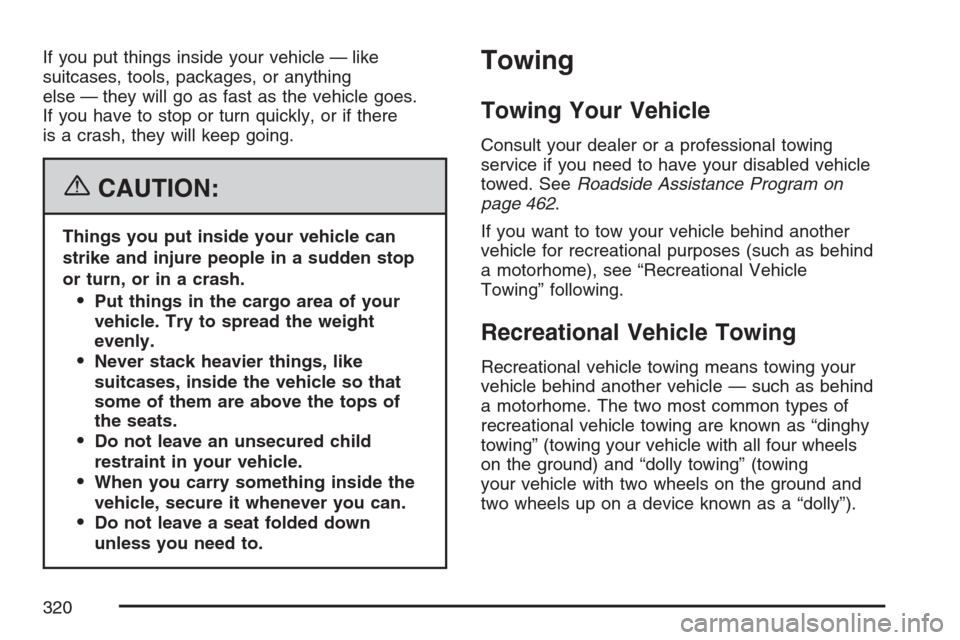
If you put things inside your vehicle — like
suitcases, tools, packages, or anything
else — they will go as fast as the vehicle goes.
If you have to stop or turn quickly, or if there
is a crash, they will keep going.
{CAUTION:
Things you put inside your vehicle can
strike and injure people in a sudden stop
or turn, or in a crash.
Put things in the cargo area of your
vehicle. Try to spread the weight
evenly.
Never stack heavier things, like
suitcases, inside the vehicle so that
some of them are above the tops of
the seats.
Do not leave an unsecured child
restraint in your vehicle.
When you carry something inside the
vehicle, secure it whenever you can.
Do not leave a seat folded down
unless you need to.
Towing
Towing Your Vehicle
Consult your dealer or a professional towing
service if you need to have your disabled vehicle
towed. SeeRoadside Assistance Program on
page 462.
If you want to tow your vehicle behind another
vehicle for recreational purposes (such as behind
a motorhome), see “Recreational Vehicle
Towing” following.
Recreational Vehicle Towing
Recreational vehicle towing means towing your
vehicle behind another vehicle — such as behind
a motorhome. The two most common types of
recreational vehicle towing are known as “dinghy
towing” (towing your vehicle with all four wheels
on the ground) and “dolly towing” (towing
your vehicle with two wheels on the ground and
two wheels up on a device known as a “dolly”).
320
Page 387 of 492
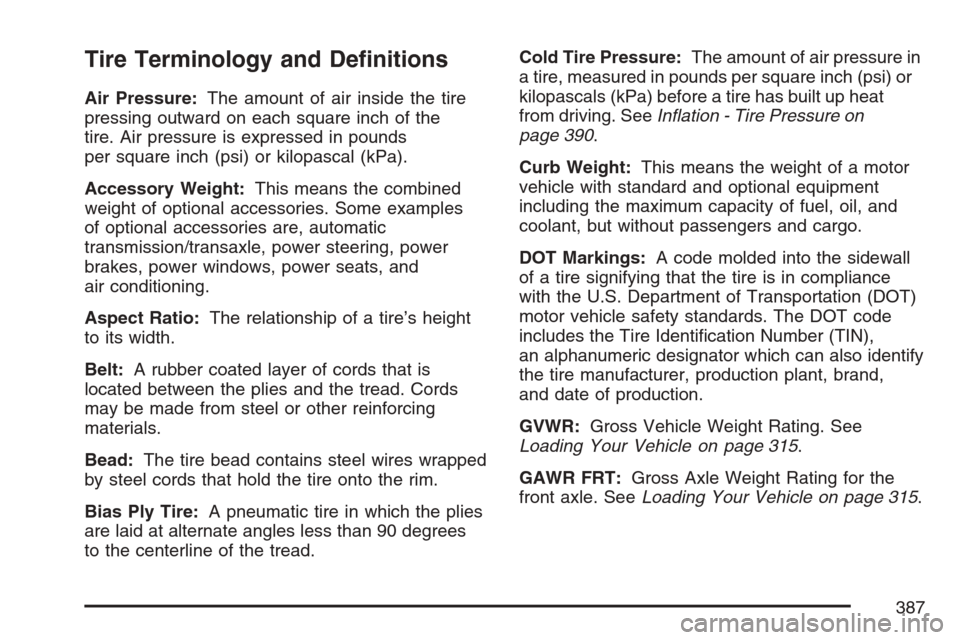
Tire Terminology and De�nitions
Air Pressure:The amount of air inside the tire
pressing outward on each square inch of the
tire. Air pressure is expressed in pounds
per square inch (psi) or kilopascal (kPa).
Accessory Weight:This means the combined
weight of optional accessories. Some examples
of optional accessories are, automatic
transmission/transaxle, power steering, power
brakes, power windows, power seats, and
air conditioning.
Aspect Ratio:The relationship of a tire’s height
to its width.
Belt:A rubber coated layer of cords that is
located between the plies and the tread. Cords
may be made from steel or other reinforcing
materials.
Bead:The tire bead contains steel wires wrapped
by steel cords that hold the tire onto the rim.
Bias Ply Tire:A pneumatic tire in which the plies
are laid at alternate angles less than 90 degrees
to the centerline of the tread.Cold Tire Pressure:The amount of air pressure in
a tire, measured in pounds per square inch (psi) or
kilopascals (kPa) before a tire has built up heat
from driving. SeeIn�ation - Tire Pressure on
page 390.
Curb Weight:This means the weight of a motor
vehicle with standard and optional equipment
including the maximum capacity of fuel, oil, and
coolant, but without passengers and cargo.
DOT Markings:A code molded into the sidewall
of a tire signifying that the tire is in compliance
with the U.S. Department of Transportation (DOT)
motor vehicle safety standards. The DOT code
includes the Tire Identi�cation Number (TIN),
an alphanumeric designator which can also identify
the tire manufacturer, production plant, brand,
and date of production.
GVWR:Gross Vehicle Weight Rating. See
Loading Your Vehicle on page 315.
GAWR FRT:Gross Axle Weight Rating for the
front axle. SeeLoading Your Vehicle on page 315.
387